Holy places of Jerusalem#
by Dmitry Moiseenko,
member of the AirPano Team that is a member of the global-geography Consortium.
2 October 2014
with kind permission of AirPano
I'd love to start my story with a description of, perhaps, the most famous city in the world. But... the highlight of my recent visit to Israel was actually how I entered the country.
Planning an AirPano trip to Jordan, I decided that since only a river separates Jordan and Jerusalem, it would be crazy not to visit and photograph the neighboring city Jerusalem.
Two years ago we made an attempt to negotiate with the Israelis to obtain a permit to shoot with our drone. Mostly, we were interested in the Old City. With the support of the Embassy of Israel in Moscow and the Ministry of Tourism of Israel in Israel, we were sure that this wouldn't be a problem.
But, after several months of correspondence, we were denied for security reasons, which is what Israel is notorious for. Carrying a weird flying camera and without papers, we would not have been able to even go through customs.
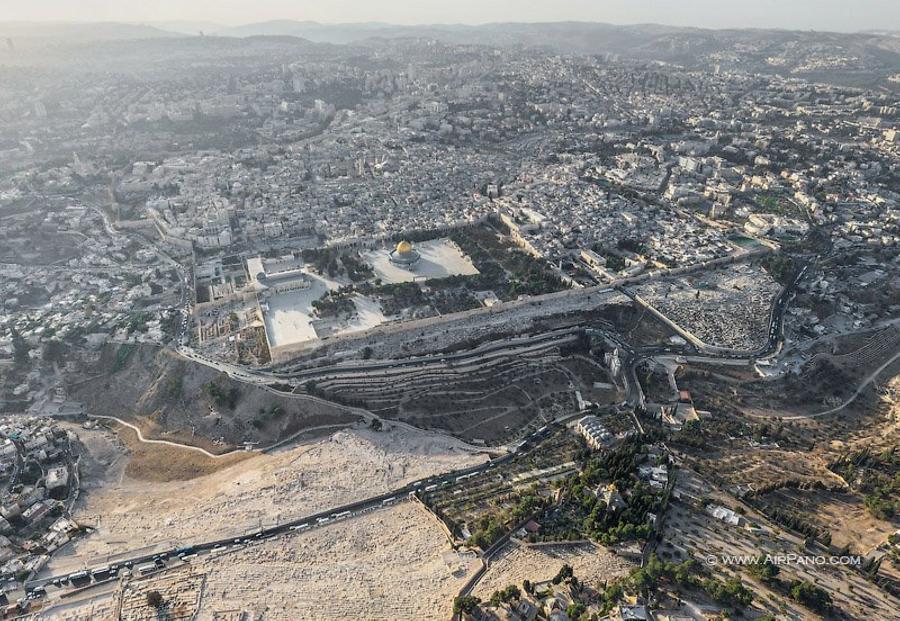
"This time, everything will be different", I thought. "I don't have any unusual photographic equipment with me". So, early in the morning, I am going to go straight from Jordan's capital, Amman, to the border checkpoint on the river, and then I will cross the King Hussein (Allenby) Bridge, and an hour later I will be in Jerusalem.
Unfortunately, I was not that lucky! First, at border control, I was questioned for half an hour about the purpose of my trip. Then they took my passport, made me sit and wait under the ruthlessly-blowing air conditioner, and only an hour later was I taken to a small room, where once more I was asked the same questions and then told to wait again. Two hours later (I had already found a place to hide, away from the air conditioner, but I was still freezing), some man approached me and asked me to answer the questions, but this time in writing. I filled out a piece of paper with my answers.
Another couple of hours later, I pleaded with them to take me to my bags so that I could get some warmer clothes. I was freezing to death. They felt sorry for me and took me to my bags. My luggage was waiting for me intact. So, my theory that something suspicious was found in my luggage was not proven.
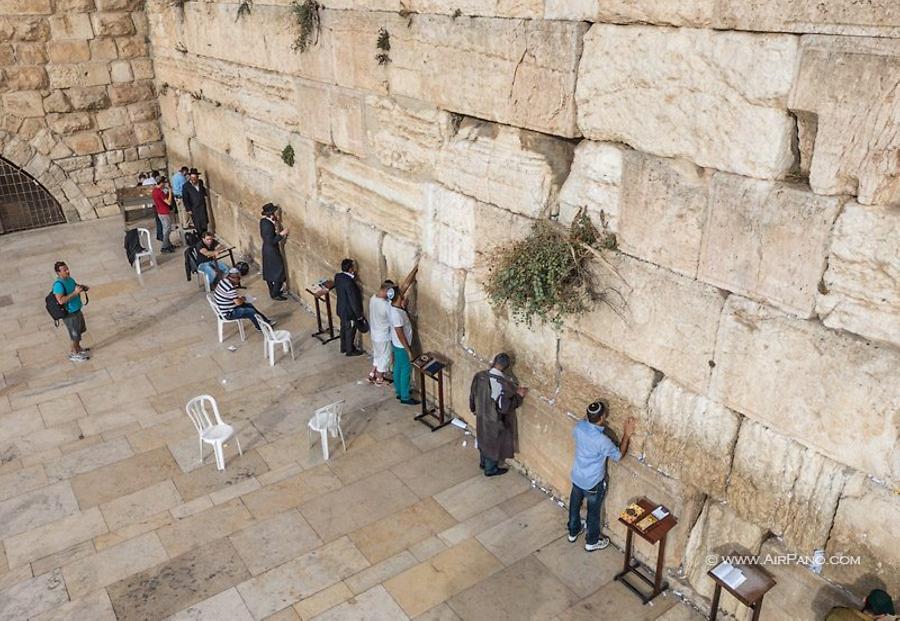
It was getting dark; I had to cancel three scheduled meetings in Jerusalem. I was called again and asked to fill out one more piece of paper... Finally, when I started thinking about how to settle down comfortably to spend the night in the passport control office, I was again taken into a small room. This was the fourth time I was asked the same questions. Finally, by some miracle, I was allowed to enter the country. It took 7 hours for my visa-free border crossing. This is a personal new record!
Late at night I finally checked into a hotel near the Jaffa Gate in the Old City. A glass of fresh pomegranate juice took the tension of my difficult day away.
To my surprise, from that moment on, no one was interested in me. I walked along the narrow streets and took pictures with my camera and monopod wherever I wanted to. First, I visited the shrine of all Christians — the Church of the Holy Sepulchre. Here, some people frantically crossed their hearts in prayer, some dropped down to the Stone of the Anointing, some just wandered from one denomination to another, and some were in line to the grotto. Surprisingly, the priests at the Greek Orthodox Church asked me to show my permits only after I had already shot almost everything.
The next point of interest was the Wailing Wall (or The Western Wall). This is the greatest shrine of Judaism and is all that is left of the Solomon's Temple that was ruined by the Romans. Now I was surprised again: not only did nobody ask me any questions, but I was invited to enter the synagogue right at the Western Wall and shoot from there. I stayed there, waiting for the sunset. For 10 shekels I was allowed to go up on the roof of a charming building overlooking the square.

It was a strange sight: a mass of people praying at the Western Wall, and above their heads — a covered footbridge, which the Arabs use to go up to The Dome of the Rock. The dome of the mosque was shining in the sunset rays, above the remains of the destroyed Temple... You can't see this from the ground level.
I am very grateful to everyone who writes to us, offering their help. In one of these letters I found Ilyas's phone number. Ilyas is a helicopter pilot who has a permit to fly over Jerusalem. I got on the phone and sent him my information so that we could obtain the necessary permits.
I was not even surprised when he called me back and told me that my request had been denied. I was prepared for this outcome after my ordeal at the passport control. However, it wasn't all bad: the ban was just for the take-off from the capital, as well as any location in Israel, with the exception being the Tel Aviv airport, where I could get a decent scan by the security service. This meant paying an additional half hour of flight time... Yes, it was unexpected, but it was still an opportunity.
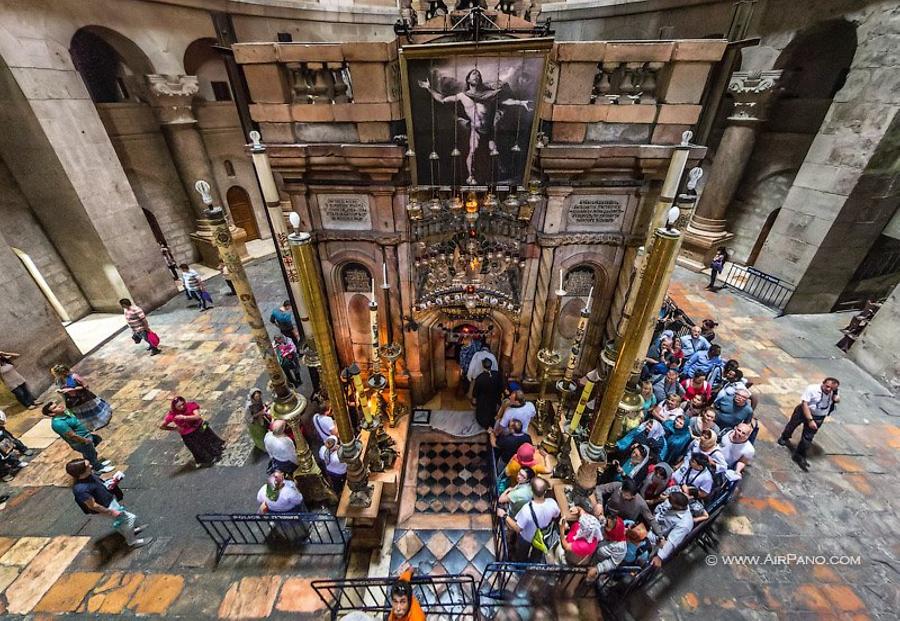
Ilyas also said that we couldn't fly closer than 1 kilometer to the walls of the Old City or fall below 300 meters. On the scheduled day, I discovered that the whole sky was covered with clouds and rain was sprinkling down ... The flight had to be postponed for a day; and it would be my last day in Israel. Waking up the next morning, I saw that the sky was covered with a haze (fog?)up to the horizon, and one could barely see the sun. All morning, every 15 minutes, I checked the weather forecast. And, all of a sudden, my iPhone showed the sun would break through the clouds for two hours. This was my last chance!
I immediately called the pilot. He was surprised by my optimism, but agreed on a departure time. Despite the fact that I was even ready for a personal search, the airport security was standard and very lenient. We took off; and 15 minutes later we could see the Jaffa Gate and the walls of the Old City. The forecast did not fail us: the sky over Jerusalem was clear. The sun was going down, the shadow covered the Western Wall of the Temple, but The Dome of the Rock was shining in the afternoon light...
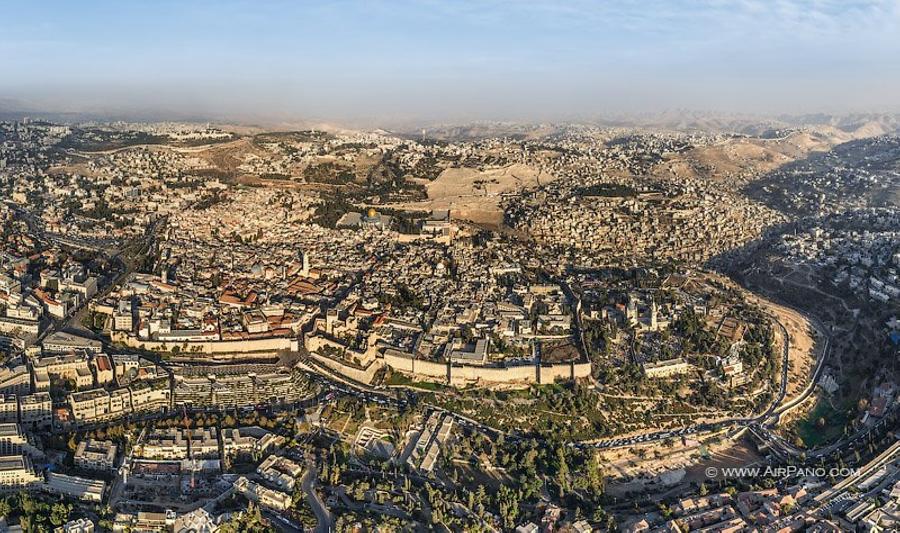
We had managed to do a few laps before the sun disappeared behind the hills surrounding Jerusalem... Somehow it reminded me of The Master and Margarita, a novel by Mikhail Bulgakov, describing this ancient city: "The darkness that came from the Mediterranean Sea enveloped the city that was loathed so much by the Procurator. The suspension bridges connecting the temple with the grim fortress of Antonia vanished; the abyss descended from the sky and drowned the winged gods above the hippodrome, the crenellated Hasmonaean palace, the bazaars, the caravanserai, the alleys, the ponds... Yershalaim, the great city, vanished as if it never existed."
At dusk we returned to Tel Aviv...
I hope everything that I managed to shoot, with the help of the wizards at AirPano, turned into a beautiful virtual tour of the city with its multi-thousand-year-old history.
And perhaps, after seeing it, the Israeli authorities will invite us again and allow us to fly over the city of Jerusalem without restrictions.
Jerusalem is one of the oldest cities on our planet. It was first mentioned in the 19th — 13th centuries BCE. The Kingdom of Judah, the empire of Alexander the Great, Syria of Seleucids, Ptolemaic Egypt, Ancient Rome, Byzantium, the Arab Caliphate, the Crusaders, the Ayyubid dynasty, the Mongol-Tatars, the Mamluk Sultanate, the Ottoman Empire, the British Empire, Jordan, and Israel all ruled Jerusalem at one point in time.
The Old City, the historical part of Jerusalem surrounded by the walls, is the "heart" of the modern city of Jerusalem. The narrow cobbled streets, majestic walls, Roman columns, and ancient buildings hold memories of the numerous legendary events. The Old City is home to three major shrines of the world's religions: Judaism, Christianity, and Islam.
The world-famous Wailing Wall is what was left of the Western Wall, which once surrounded the Second Jerusalem Temple. In 568 BCE, the Babylonian king, Nebuchadnezzar, destroyed the First Temple, which had been built by King Solomon in 960 BCE. The Second Temple was damaged during the Jewish War in 70 CE. The 156-meter-high Wailing Wall, made of huge tightly fit stone monoliths, is the only remaining fragment of the temple.

One can see people praying here and placing notes in the cracks of the Wailing Wall practically at any time of the day. This is also the final destination where believers from all over the world address their letters to "God in Jerusalem". When there are too many notes embedded in the Wall, they are taken out and buried, because the Talmud prohibits destroying paper if God's name is written on it.
David's Citadel is one of many landmarks in Jerusalem. It was built in the 2nd century BCE to protect the Old City. It was destroyed and rebuilt anew numerous times. The Tower of Phasael (King Herod named it after his brother, who committed suicide) is the only one of three Citadel towers that survived until the present day. David's Tower earned its modern name from Byzantine Christians, who believed that this was the location of the Biblical king's palace.
The Church of the Holy Sepulcher (also known as the Church of the Resurrection), the most important Christian relic, is located in the northwest part of the Old City, in the center of the Christian Quarter. It is believed that this is where Jesus Christ was crucified, buried, and then resurrected. Like many other ancient landmarks of Jerusalem, the Church of the Holy Sepulcher went through several reconstructions. Now, it is a massive architectural complex, which contains the Calvary (Golgotha), along with the Rock of Calvary, several monasteries, churches (including the underground church), galleries, and so forth.
The Church of the Holy Sepulcher is shared by six denominations of the Christian church: Greek Orthodox, Catholic, Armenian, Coptic, Syrian, and Ethiopian. Each of them has a dedicated chapel and specified time for prayer. In order to avoid misunderstandings between different denominations (as conflicts often occurred in the past), starting in 1192 CE, the "independent party", specifically, Arab families, was given ownership of the key to the church and therefore has the right to open its gates.
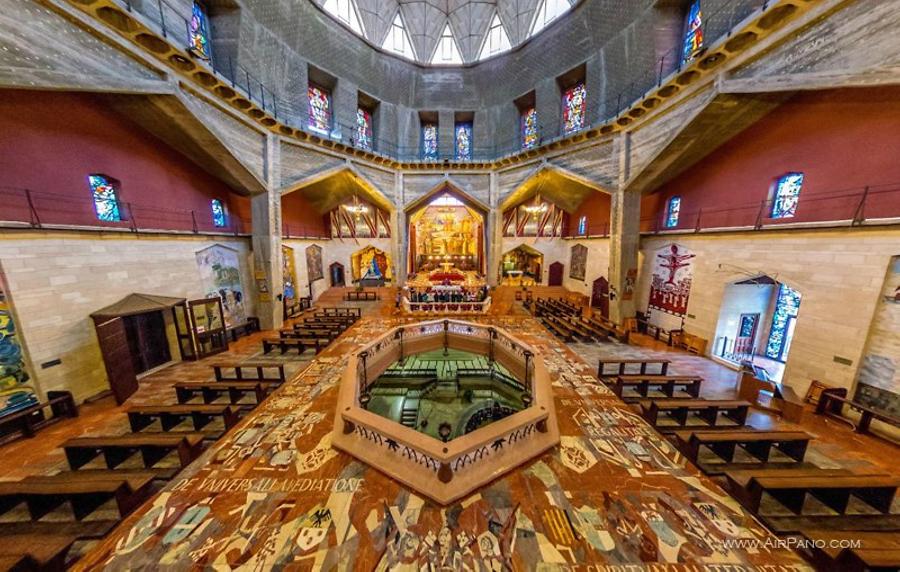
The Muslim Quarter, home to many landmarks and relics, occupies the northeast part of the Old City. The most famous is al-Aqsa Mosque; a holy place located on top of the Temple Mount. The mosque can accommodate 5,000 people simultaneously. Muslims believe that Muhammad was miraculously transported one night from Mecca to this very place, whereupon he ascended to Heaven.
There are a great number of other landmarks outside of the Old City, such as Kidron (or Jehoshaphat) Valley (where the tombs of the Christian era reside), the Garden of Gethsemane, the Tomb of the Virgin, and the Church of St. Mary, which is located on the Mount of Olives and was built by the Russian emperor Alexander III.
The Mount of Olives (or Mount Olivet) offers a picturesque view of the Old City with its thick fortification walls surrounding 34 towers and 8 gates, domes of the churches, mosques, and synagogues... Our photo panoramas will give you an opportunity to see the numerous landmarks of Jerusalem in detail.
- Siehe auch Österreich und das heilige Land
13 Panoramas of Holy places of Jerusalem